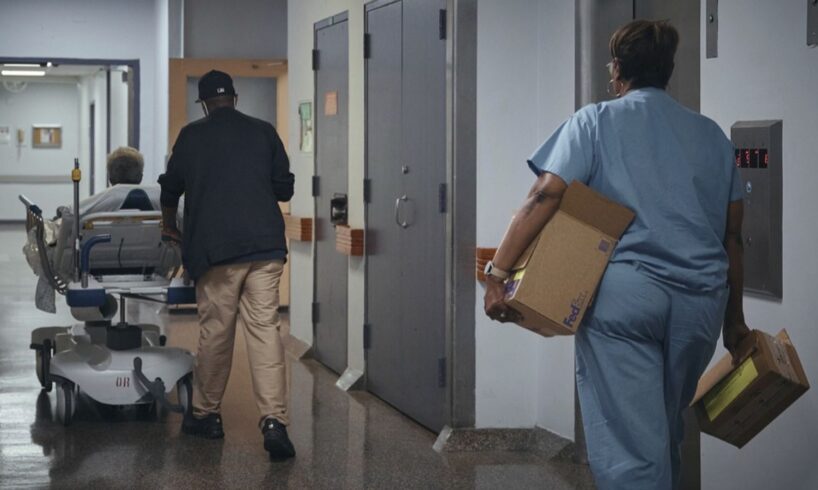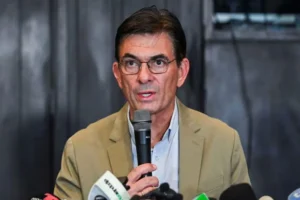
A nurse transports a patient on a stretcher inside Brookdale University Hospital and Medical Center on Tuesday, July 1, 2025, in the Brooklyn borough of New York. [AP Photo/Andres Kudacki]
Mass layoffs across the U.S. healthcare industry continue to accelerate, further straining a system already overburdened by workforce shortages. This is part of a wider jobs massacre, with US employers announcing 1.1 million jobs this year alone.
This week, Providence announced it is cutting approximately 450 staff in the Washington and Oregon area. These cuts, which are set to take place in early 2026, will impact more than 100 departments, including front line clinical healthcare workers. Providence has already laid off 200 this year, and also announced a restructuring plan in June that impacted 600 full-time jobs.
Chicago-based Oak Street Health, which is part of CVS, also announced this week that it is cutting 219 jobs early next year. Last month, they announced they would close 16 Oak Street Clinics starting in February 2026. These operate as primary care facilities for seniors.
Earlier this month, Pennsylvania-based Tower Health announced 350 layoffs, including medical staff at Pottstown Hospital in Montgomery County. Tower Health owns multiple hospitals in the region and it is unclear what other hospitals will be impacted with these layoffs.
Earlier this month, Optum care announced mass layoffs and clinic closures across New Jersey, with 572 jobs to be terminated next year, and 90 clinics to be closed, mostly by the end of November. These clinics provide essential primary care for children and adults, who are now left scrambling to find other healthcare options.
In late October, PeaceHealth, which owns nine hospitals in Oregon, Washington and Alaska, announced it would lay off 2.5 percent of its workforce, roughly 400 workers.
Mehring Books
The Wuhan Lab Lie and the Fight for Scientific Truth
This pamphlet provides an overview of the principled stand taken by the WSWS against the far-right Wuhan Lab Lie. It is essential reading for all those seeking to defend science and public health.
Also in late October, Point32Health—the second-largest health insurer in Massachusetts—laid off 254 workers, representing 6.7 percent of its workforce. This followed an earlier reduction of 110 employees in March. Another health insurer, Oregon-based PacificSource, announced mass layoffs in late October affecting roughly 300 workers across Oregon, Montana, Idaho and Washington. In early October Kaiser Permanente announced layoffs for 216 workers, little more than a week before nurses went on a 5 day strike.
These layoffs are part of a major escalation of healthcare workforce reduction. In July, the WCH Service Bureau released a ‘deep dive’ into the staggering level of healthcare layoffs in 2025, noting that the industry ‘is experiencing an unprecedented wave of workforce reductions in 2025, with 51 hospitals and health systems announcing layoffs affecting tens of thousands of employees.’
Federal workers have also been a primary target, with roughly 10,000 full-time jobs being cut in the Department of Health as part of the federal job cuts pursued by the Trump regime. This includes around 4,300 workers at the Centers for Disease Control, a third of the workforce.
These layoffs are taking place most of the way through the 5th year of the COVID-19 pandemic which is estimated to have killed more than 30 million people worldwide, with hundreds of millions suffering with long covid causing potentially life long disabilities. The COVID-19 virus continues to rapidly mutate and present a significant threat to public health.
Hospital closures have also increased this year, bringing devastating consequences in particular for rural communities. According to a November report from the Center for Healthcare Quality and Payment Reform, 27 hospitals have closed or are in the process of closing so far this year, surpassing the 21 closures recorded in 2024.
April and May, Taylor Hospital and Crozer-Chester Medical Center shut their doors in Delaware County, Pennsylvania, resulting in thousands of layoffs. Together, these hospitals had handled more than 78,000 emergency room visits and over 54,000 inpatient and outpatient cases annually. These tens of thousands of visits will be redirected to other hospitals in the area, increasing the burden on the understaffed healthcare system.
The ruling class is stripping away social spending in order to sustain ever-expanding profits. Trump’s Big Beautiful Bill, which was signed into law in July, slashed over $800 billion from Medicaid over the next decade, with Medicare likely to see $500 billion of cuts in the period between 2026 and 2034. These cuts will result in millions of people losing their healthcare, increased healthcare costs across the board, and an escalation of the mass layoffs among healthcare workers.
There is no shortage of resistance among healthcare workers, who are on the front lines of the class struggle, striking over understaffing, stagnant wages, and ongoing layoffs.
Earlier this week, hospital workers across the University of California (UC) healthcare system held a two-day strike, confronting the Democratic Party–controlled system that refuses to provide a livable wage. According to the union, roughly 40,000 workers participated.
Last week, 600 nurses in New Orleans held a three-day strike demanding improved staffing ratios and raises that many workers have not received in over a decade. This marks the fifth strike in two years.
Last month, 46,000 Kaiser healthcare workers held a limited five-day strike demanding better working conditions, wages and staffing. A month later, they are still working under an expired contract.
But in every case, these struggles are being limited and isolated from each other by the healthcare union bureaucracy. While workers want to fight to defend the social right to healthcare, the union bureaucracy is motivated by protecting its corrupt ties with management and the government. At Kaiser, the workers in last month’s strike are in the Alliance of Health Care Unions (AHCU), which participates in the Labor Management Partnership. This corporatist body receives millions of dollars a year from Kaiser, and its explicit aim is to prevent strikes.
Healthcare workers are coming to grips with the fact that a serious confrontation against the capitalist system that subordinates healthcare to private profit is needed. But to do this, workers must build rank and file power and develop a politically independent leadership that is rooted in the interests of the working class.
Healthcare workers must answer to the call of the International Workers Alliance of Rank-and-File Committees (IWA-RFC) to build rank and file committees as part of a broader movement of the working class to confront this catastrophe of widespread layoffs. The far advanced crisis of capitalism can only be resolved by the international working class in a united struggle against capitalism.
Get information about building or joining a health workers rank-and-file committee





